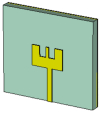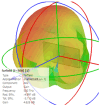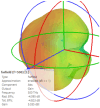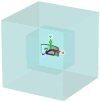Simulation and Optimization of the Antenna Designs for Glucose Biosensing FRET Mechanisms in Endoscopic Capsules
- PMID: 40572362
- PMCID: PMC12195417
- DOI: 10.3390/mi16060641
Simulation and Optimization of the Antenna Designs for Glucose Biosensing FRET Mechanisms in Endoscopic Capsules
Abstract
An optimized design of photodetectors and antennas for Förster Resonance Energy Transfer (FRET)-based glucose biosensing in endoscopic capsules is presented. The compact antenna design is tailored for the visible optical frequencies (~526 THz) associated with FRET-based glucose monitoring and integrates structural flexibility to conform to the spatial constraints of endoscopic capsules, such as mechanical bending features. The antenna is embedded in a multimode medium artificial tissue simulating a glucose environment with several layers, providing efficient coupling to the FRET emission signal for glucose sensing. Stable S11 parameters and a maximum gain of 9 dBi are realized by statelier mesh settings, bend adaptation, and cautious SAR constraint handlers. Results of the Specific Absorption Rate (SAR) confirm the limited energy absorption within permissible bounds, confirming its application for biomedical purposes. These results affirm the feasibility of non-invasive glucose measurement in interstitial fluid in this configuration that can be operable through an endoscope with improved sensitivity and functionality.
Keywords: CST Studio Suite; FRET-based biosensing; SAR calculation; antenna design; endoscopic capsule; glucose sensing; non-invasive glucose monitoring; photodetector optimization; visible optical frequency.
Conflict of interest statement
The authors declare no conflict of interest.
Figures

















Similar articles
-
Health professionals' experience of teamwork education in acute hospital settings: a systematic review of qualitative literature.JBI Database System Rev Implement Rep. 2016 Apr;14(4):96-137. doi: 10.11124/JBISRIR-2016-1843. JBI Database System Rev Implement Rep. 2016. PMID: 27532314
-
Endoscopic Posterior Cervical Foraminotomy and Discectomy.JBJS Essent Surg Tech. 2025 Jun 25;15(2):e24.00003. doi: 10.2106/JBJS.ST.24.00003. eCollection 2025 Apr-Jun. JBJS Essent Surg Tech. 2025. PMID: 40567511 Free PMC article.
-
Signs and symptoms to determine if a patient presenting in primary care or hospital outpatient settings has COVID-19.Cochrane Database Syst Rev. 2022 May 20;5(5):CD013665. doi: 10.1002/14651858.CD013665.pub3. Cochrane Database Syst Rev. 2022. PMID: 35593186 Free PMC article.
-
The measurement of collaboration within healthcare settings: a systematic review of measurement properties of instruments.JBI Database System Rev Implement Rep. 2016 Apr;14(4):138-97. doi: 10.11124/JBISRIR-2016-2159. JBI Database System Rev Implement Rep. 2016. PMID: 27532315
-
NIH Consensus Statement on Management of Hepatitis C: 2002.NIH Consens State Sci Statements. 2002 Jun 10-12;19(3):1-46. NIH Consens State Sci Statements. 2002. PMID: 14768714
References
-
- Bai X., Ga L., Du Y., Ai J. Carbon Quantum Dot-Based Label-Free Fluorescent Biosensor to Detect E. coli. IEEE Sens. J. 2024;24:25284–25290. doi: 10.1109/JSEN.2024.3419135. - DOI
-
- Haleem A., Javaid M., Singh R.P., Suman R., Rab S. Biosensors applications in medical field: A brief review. Sens. Int. 2021;2:100100. doi: 10.1016/j.sintl.2021.100100. - DOI
LinkOut - more resources
Full Text Sources
Miscellaneous

